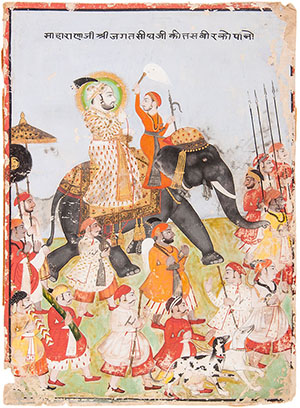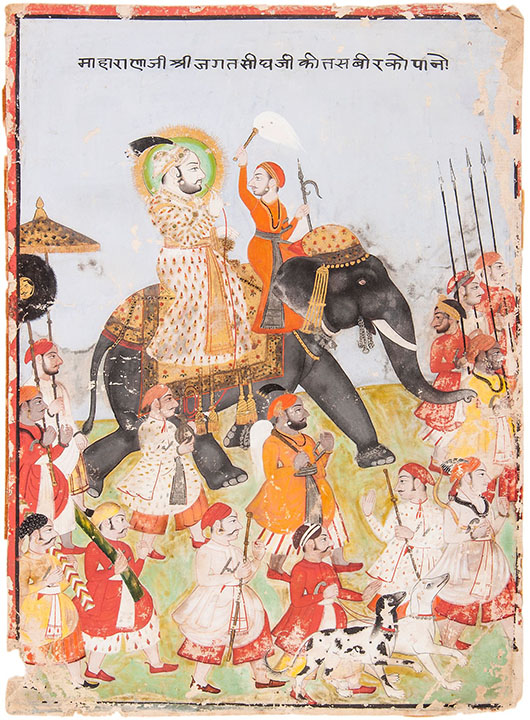
LONDON – Dreweatts & Bloomsbury Auctions will conduct an Interior sale on Wednesday, March 12, featuring Asian Art from private UK collections, alongside English delftware and a stunning selection of carpets to suit all budgets and tastes. LiveAuctioneers.com will provide Internet live bidding.
A painting depicting Maharana Jagar Singh II riding in procession on an elephant leads a fine collection of Indian miniatures. Highlighted with gilding, the opaque watercolor dated circa 1740 is from Rajasthan “the land of Kings” in west India. Opaque watercolor or gouache uses “Chinese White” zinc oxide paint to create an opaque effect, adding more body and brightness to a painting. The Metropolitan Museum of Art houses a similar painting, Maharana Jagat Singh II in Procession. This example, from a private UK collection is estimated at £800-£1,000 [Lot 80].
Other opaque watercolor and gold examples of Indian miniatures include a 19th century Indian Company School painting housed in a carved wooden frame, estimated at £500-£700 [lot 74] and a folio from the Ragamala series, dated 1660-1680. It is estimated at £300-£500 [Lot 77]. Works from the Ragamala series symbolize the fusion of poetry, art and music in medieval India. The word Ragamala means “garland of Ragas” and a raga is a musical phrase that evokes an emotional response, associated with a particular time of day, season or mood.
A black crepe silk child’s kimono highlights a fine collection of Japanese textiles. Decorated with cranes, symbolic of longevity and good-fortune, and highlighted with gold thread, the early 20th century kimono is from the Taisho period and is estimated at £150-£200 [Lot 97].
A collection of English delftware emphasises the influence of other cultures on British products. Iconic Chinese blue and white porcelain was imported to Europe from the mid-16th century, and although the Chinese would not disseminate the recipe for true porcelain, the Dutch responded with the production of delftware from the town of Delft in the Netherlands. The tin-glazed earthenware was cheaper than its Chinese counterpart and was developed using tin-oxide to create a whiter ground that mimicked the fashionable Chinese blue & white porcelain. Production using the glaze was copied across Europe, and in the UK was called English delftware.
Unlike their European counterparts, early Dutch and English delft emulated the Chinese style of decoration. A flower brick from Bristol, one of the key production centres in the UK, is an example, circa 1740. The flower brick bears paper labels for Jonathan Horne, London. A prominent figure at the heart of English and Continental delftware, he was appointed MBE for his services to medieval English ceramics. With its excellent provenance and generally fine condition, this example is estimated at £600-£800 [Lot 154].
Tin-glaze, outside of England and the Netherlands, developed along more European lines with an Italian Renaissance and French Baroque style. Despite the limitations of using only the mineral pigments that would fuse to the tin-glaze, the introduction of a polychrome palette saw this European style filter into English delft. An example, probably from Vauxhall circa 1730, shows a stylized English garden, complete with cockerel, highlighted with reds, yellows and greens. It is estimated at £500-£800 [Lot 306].
Also from a London production center is an unusual English Delftware blue and white colander, from Lambeth circa 1770. It is decorated with houses in an oriental landscape and is estimated at £250-£350 [Lot 336].
A fine selection of rugs and carpets include a part silk Kashan rug estimated at £200-£300 [Lot 438] and a Tabriz carpet estimated at £800-£1,000 [Lot 333]. Tabriz is the capital city of the East Azerbaijan Province of northern Iran and has historically made a diverse range of carpets to suit all tastes and budgets. Another example from Tabriz is a pair of rugs decorated with polychrome flowering urns, estimated at £300-£500 [Lot 354].
View the fully illustrated catalog and register to bid absentee or live via the Internet as the sale is taking place by logging on to www.liveauctioneers.com.
ADDITIONAL LOT OF NOTE



